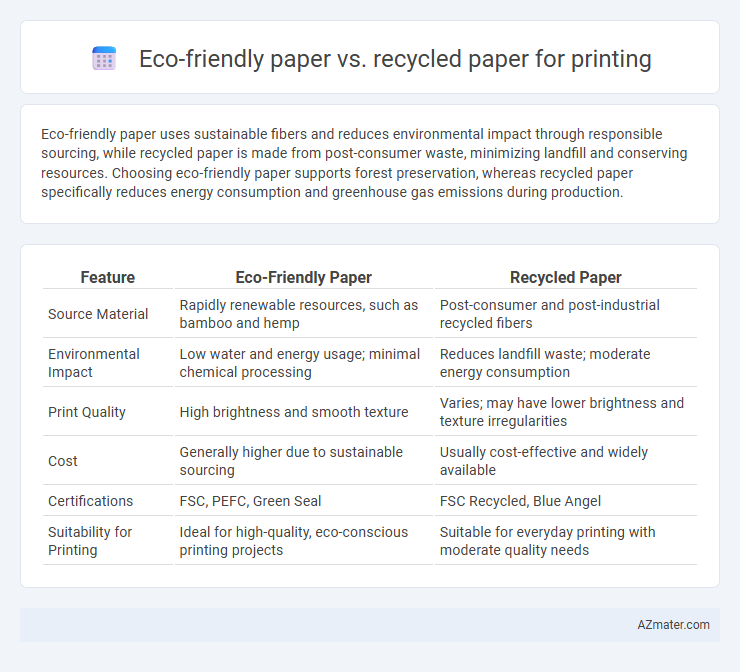Eco-friendly paper uses sustainable fibers and reduces environmental impact through responsible sourcing, while recycled paper is made from post-consumer waste, minimizing landfill and conserving resources. Choosing eco-friendly paper supports forest preservation, whereas recycled paper specifically reduces energy consumption and greenhouse gas emissions during production.
Table of Comparison
| Feature | Eco-Friendly Paper | Recycled Paper |
|---|---|---|
| Source Material | Rapidly renewable resources, such as bamboo and hemp | Post-consumer and post-industrial recycled fibers |
| Environmental Impact | Low water and energy usage; minimal chemical processing | Reduces landfill waste; moderate energy consumption |
| Print Quality | High brightness and smooth texture | Varies; may have lower brightness and texture irregularities |
| Cost | Generally higher due to sustainable sourcing | Usually cost-effective and widely available |
| Certifications | FSC, PEFC, Green Seal | FSC Recycled, Blue Angel |
| Suitability for Printing | Ideal for high-quality, eco-conscious printing projects | Suitable for everyday printing with moderate quality needs |
Introduction to Eco-Friendly and Recycled Printing Paper
Eco-friendly printing paper is produced using sustainable methods, often derived from rapidly renewable resources and processed without harmful chemicals, reducing environmental impact. Recycled printing paper contains fibers reclaimed from post-consumer or post-industrial waste, minimizing deforestation and landfill accumulation while conserving energy. Both types aim to reduce carbon footprint and promote responsible resource use in printing applications.
Defining Eco-Friendly Paper: Features and Benefits
Eco-friendly paper is produced using sustainable resources such as bamboo, hemp, or certified sustainable wood pulp, minimizing environmental impact through reduced energy consumption and lower carbon emissions during manufacturing. It often incorporates chlorine-free bleaching processes and avoids toxic chemicals, enhancing biodegradability and reducing pollution. These features result in printing paper that supports forest conservation and reduces landfill waste while maintaining high quality and print performance.
What Is Recycled Paper? Production and Advantages
Recycled paper is produced by reprocessing used paper fibers into new sheets, significantly reducing the need for virgin wood pulp and minimizing environmental impact. The production process involves collecting, sorting, deinking, and pulping post-consumer or post-industrial paper waste, which conserves energy and water compared to traditional paper manufacturing. Advantages include lowering deforestation rates, reducing landfill waste, decreasing greenhouse gas emissions, and often cost-effectiveness, making it a sustainable choice for printing paper.
Environmental Impact: Eco-Friendly vs Recycled Paper
Eco-friendly paper often utilizes sustainable materials such as bamboo, hemp, or rapidly renewable fibers, reducing deforestation and habitat destruction. Recycled paper minimizes waste by repurposing post-consumer and post-industrial paper, significantly lowering energy consumption and greenhouse gas emissions compared to virgin paper production. Both options contribute to environmental preservation, but eco-friendly paper emphasizes renewable sourcing, while recycled paper prioritizes waste reduction.
Sourcing Materials: Sustainability Comparison
Eco-friendly paper is primarily sourced from sustainably managed forests or alternative fibers like bamboo and hemp, ensuring minimal environmental impact through responsible harvesting practices and reduced deforestation. Recycled paper relies on post-consumer waste, reducing the demand for virgin pulp and significantly lowering energy consumption and water usage in production. While recycled paper reduces landfill waste, eco-friendly paper emphasizes renewable resource management and often incorporates certifications such as FSC or PEFC for verified sustainability.
Printing Quality: Eco-Friendly vs Recycled Options
Eco-friendly paper for printing typically offers superior printing quality with smoother surfaces and consistent brightness levels, enhancing sharpness and color vibrancy in printed materials. Recycled paper, while environmentally beneficial, may present slight variations in texture and fiber composition that can affect ink absorption and result in less crisp, muted prints. Choosing eco-friendly paper ensures higher fidelity in detailed graphics and text, making it preferable for professional printing needs.
Cost Analysis: Affordability and Value
Eco-friendly paper often incurs higher production costs due to sustainable sourcing and chemical-free processing, resulting in a pricier option compared to recycled paper. Recycled paper benefits from lower raw material expenses as it primarily uses post-consumer waste, making it a more affordable choice for large-scale printing. The value of eco-friendly paper lies in its reduced environmental impact and compliance with green certifications, while recycled paper balances cost-effectiveness with moderate environmental benefits.
Certifications and Standards for Green Paper
Eco-friendly paper for printing often carries certifications such as FSC (Forest Stewardship Council) and PEFC (Programme for the Endorsement of Forest Certification), ensuring responsible forest management and sustainable sourcing. Recycled paper typically meets standards like Green Seal or Blue Angel, which certify the use of post-consumer waste and eco-friendly production processes. Both types of green paper adhere to ISO 14001 environmental management standards, promoting reduced environmental impact and resource conservation.
Choosing the Right Paper for Your Printing Needs
Eco-friendly paper often uses sustainable fibers and production methods that reduce environmental impact, making it ideal for businesses prioritizing green certifications. Recycled paper, composed of post-consumer waste, offers a cost-effective solution while conserving resources and reducing landfill waste. Selecting the right paper depends on print quality requirements, budget constraints, and specific ecological goals in your printing projects.
Conclusion: Which Paper Is the Better Choice?
Eco-friendly paper is created using sustainable resources and processes that minimize environmental impact, while recycled paper is made from repurposed fiber, reducing waste and conserving natural resources. Choosing between eco-friendly and recycled paper depends on specific needs: eco-friendly paper often ensures lower chemical use and renewable sourcing, whereas recycled paper excels in diverting waste from landfills. For printing purposes, selecting certified eco-friendly paper or high-quality recycled paper with certifications like FSC or Green Seal provides the best balance of environmental benefits and print performance.

Infographic: Eco-friendly paper vs Recycled paper for Printing paper
 azmater.com
azmater.com